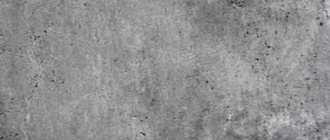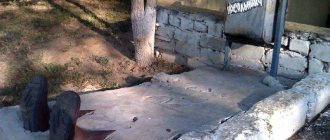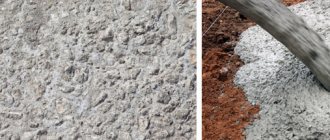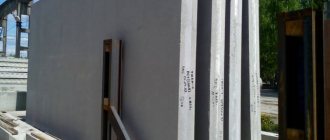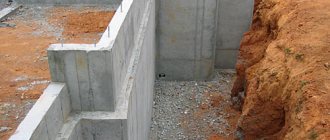Monolithic reinforced concrete is associated with the concept of monolithic construction. If prefabricated or monolithic-prefabricated structures are produced ready-made, then monolithic walls and foundations are formed directly during construction. Let's talk about this material, its characteristics, and the technology for constructing buildings from monolithic reinforced concrete.
Features of the material
The main difference between a monolithic material and a prefabricated one is the manufacturing method. Precast concrete - piles, wall panels, stairs - are produced in a factory in molds and transported to the construction site in finished form.
Monolithic involves a different method.
- At the first stage, a reinforcement frame is constructed. Since we are talking about load-bearing structures, the diameter of the reinforcement is usually 12 mm or more. In addition, reinforcing mesh, clamps, etc. are used.
- Then formwork is built around the future structure, which acts as a form.
- Concrete of the appropriate grade is poured into the mold - slag concrete, expanded clay concrete, heavy. The material is compacted mechanically using deep or surface vibrators.
- The required time is allowed for the concrete to harden.
75-80% of monolithic reinforced concrete is used in the zero cycle - the foundation, and only the remaining 20-25% is used for the above-ground part of the structure - concrete load-bearing columns and monolithic floor slabs.
The following video will tell you about checking the strength of a reinforced concrete structure:
Reinforced concrete products
For prefabricated reinforced concrete structures, a number of products are used, which are manufactured on steam reinforced concrete products by vibration. Of course, it is impossible to do this at home, since technical conditions will not allow it (the basic lack of necessary equipment). The only thing that can at least somehow resemble a factory-made reinforced concrete product is something that can be done at home on an improvised vibrating table. But in this case, due to the inability to use steam, the product will have a drawdown, since water releases volume during evaporation.
Reinforced concrete slabs
Floors are transported flat with spacers made of wooden slats Source mskukraine.com
Reinforced concrete floor slabs in modern construction can be called the most popular material, since they are used to make not only ceilings, but also floors, or one floor performs a double function. This filling has a hollow structure, where the internal holes not only significantly reduce the weight of the product (almost half), but can also serve as cable channels for laying various communications. As a rule, this is wiring for ceiling (upper) lighting, but sometimes it can be alarm, TV or Internet cables.
Advantages and disadvantages
Monolithic reinforced concrete has its advantages and disadvantages. They are connected precisely with the technological process. The characteristics of the structure itself will depend on the grade of concrete and the quality of the reinforcement.
- The speed of constructing a structure made of concrete is much higher than that of brick or stone.
- The use of slabs allows you to reduce the thickness of the walls, and, therefore, increase the area of the apartment. Monolithic work allows you to complicate the layout and abandon standard schemes, since the blocks are not tied to the standard size of the slabs, as in the case of construction using precast reinforced concrete.
- The monolithic structure is highly durable and can withstand an earthquake of up to magnitude 8 without destruction.
- The minimum number or complete absence of seams increases thermal insulation.
The disadvantages of the method include the following.
- The construction is highly labor-intensive, since, in fact, the entire production cycle is carried out at the construction site, excluding only the preparation of concrete, and even then not always.
- Monolithic reinforced concrete requires the participation of additional lifting equipment, especially when it comes to the above-ground part of the building.
- The construction of a monolithic structure requires large financial costs.
Construction from a monolith
Stages:
- site preparation;
- installation of formwork;
- installation of fittings;
- concrete hardening.
After the concrete has hardened, the formwork is removed. But there are exceptions.
Formwork options
Formwork is the main component of construction using monolithic concrete. When constructing objects, builders use different types of formwork. The most popular is collapsible and removable. In rare cases, developers use permanent formwork, which is made of corrugated sheets, polystyrene foam blocks or hollow elements. This kind of formwork is “two in one”: the corrugated sheet acts as an external finish, and the blocks serve for thermal insulation.
Sometimes the developer independently makes prefabricated panel formwork from materials that are at hand. The base is made of boards and beams or moisture-resistant plywood. The panels are connected into a solid structure using threaded rods, nuts and wooden blocks. The dimensions depend on the purpose of construction - it will be a cellar, staircase, foundation or wall. This type of formwork is characterized by ease of dismantling, limited turnover, low weight, weak resistance, low thermal conductivity and short service life.
Sometimes craftsmen use metal formwork, which is made from carbon steel at enterprises that produce metal structures. The components of the formwork are marked accordingly. A special lubricant is applied to the sides in contact with the concrete mixture. It will make dismantling easier in the future. Other surfaces are coated with paint. The advantages of this design are rigidity, long period of use, and resistance to deformation. The disadvantages include large mass, poor thermal conductivity and high cost.
Reinforcement works
To make concrete elements more resistant to various loads, they are reinforced with reinforcing steel. This is how reinforced concrete is obtained. Depending on the purpose, there are working, distribution and installation fittings. During construction, it is placed either individually or by connecting it into grids and frames.
Concrete works
The following stages are distinguished:
- mixing a mixture of components or delivering a ready-made mixture from the factory;
- pouring formwork;
- hardening.
Small volumes of the mixture are made directly at the construction site using concrete mixers, while larger volumes are ordered from the manufacturer. It can be delivered to the site either by concrete mixer trucks or concrete pumps. During delivery, the mixture needs to be protected from precipitation, heat or freezing. During construction, the mixture is laid with some compaction. To do this, workers use special electromechanical vibrators.
At the last stage, hardening of the monolith occurs, during which the following follows:
- in winter, provide suitable conditions for gaining at least 50% of the design strength (insulate the structure with mats, sawdust or slag);
- In summer, protect surfaces from bright sun and rapid drying under strong gusts of wind.
Specifications
Concrete is characterized by good resistance to compression, but insufficient resistance to tension. A metal frame made of monolithic reinforced concrete is designed to neutralize this property, which, in turn, shows excellent results in tension, but insufficient results in compression. The combination of both materials allows you to take advantage of only their advantages during construction.
The remaining characteristics of structures are determined by the type of concrete.
- Lightweight concrete - expanded clay concrete, sawdust concrete, etc., are used for lightweight structures and to reduce thermal conductivity, since in these indicators concrete is inferior to clay brick.
- Heavy concrete - with a density of 2200–2500 kg/cubic meter ensures the reliability of load-bearing structures and foundations. The mixture is selected according to cash registers - B1, B2, B1.5.
A variety of additional components are introduced into the composition of concrete to obtain certain properties. Thus, the same sawdust in the composition of the corresponding brand increases the thermal insulation qualities, and the addition of rocks increases strength.
Now let's talk about the thermal conductivity of monolithic reinforced concrete. The thermal conductivity of the stone depends on the filler.
- Monolithic concrete without additives has the maximum thermal conductivity - 1.75 W/(m deg).
- The performance of the mixture with the addition of crushed stone and gravel is slightly better - 1.51 W/(m deg).
- The indicators of the material on sand, slag and with the addition of silicates range from 0.3 to .81 W/(m deg).
- Special thermal insulation concrete has the maximum thermal insulation characteristics - 0.18 W/(m deg), as well as a mixture based on volcanic slag - 0.2–0.5 W/(m deg), which corresponds to the performance of ceramic slotted and hollow bricks.
The design solution of monolithic reinforced concrete is regulated by GOST and the relevant SNiP requirements. The documents indicate possible schemes and those products that can be used for the construction of certain elements. According to GOST, the load-bearing system of a building must be a single whole consisting of a foundation, vertical supports - walls and columns, and horizontal slabs - floors and coverings.
It is worth noting that the slabs, in fact, are already elements of prefabricated monolithic construction. However, in the documentation they are also called monolithic structures.
Why is it necessary to obtain monolithic reinforced concrete, what is its scope, read on.
Compound
All structures of the facility made of monolithic concrete are erected from building materials of grade M300, M250 or M200. The final choice is determined by the state of the groundwater and the climatic conditions of the area where the construction of the facility will take place. M200 concrete is considered the best option.
Contains:
- quarry sand and granite crushed stone;
- particle fraction 1-2 cm;
- CEM I 32.5H PC or CEM 42.5H PC.
Depending on the pouring conditions, the mixture may additionally contain a setting accelerator, plasticizer, and additives - antifreeze, hydraulic, or strength.
Application environment
Reinforced concrete structures are the basis of construction today, so the scope of their application can safely be called all conceivable construction work (construction of private houses from monolithic reinforced concrete, cottages, other buildings, etc.).
- The type of foundation depends on geodetic conditions. However, the basis of most structures is monolithic reinforced concrete. Strip foundation - slabs of variable thickness are laid under columns or under walls and columns of a structure.
- A monolithic slab under the area of the entire building is the most material-intensive option.
- A slab foundation with a large thickness can be modified if the structural design allows it. In this case, ribbed and box-shaped slabs are used.
- Pile foundation - used on soft soils.
Next, you will find out what documents are required for the acceptance of monolithic reinforced concrete.
The following video will tell you about the technology of constructing buildings made of monolithic reinforced concrete:
Documents for acceptance
The construction of monolithic reinforced concrete structures is part of the construction work and is accepted as construction progresses by a special selection committee.
A prerequisite is a laboratory analysis of the finished concrete mixture before pouring. The acceptance certificate contains corresponding columns where it is required to indicate the technical characteristics of the material - frost resistance, water resistance and average strength, calculated from a series of control samples.
Steel reinforcement is also inspected. If there is a deviation from SNiP standards, the material cannot be used in construction.
The document for acceptance of the finished structure is the inspection and acceptance certificate. It states:
- numbers of working drawings used;
- numbers of work performed from the construction journal and the designer's supervision journal;
- acts of acceptance of preliminary work, if any;
- laboratory test results;
- geometric dimensions of the structure and their deviations from the planned ones, if any;
- compliance with the working design and SNiP;
- inspection - here possible defects are indicated, the condition of the surface is assessed, etc.
The acceptance certificate is carried out upon delivery of any intermediate finished structure, and not the entire wall or floor.
Calculation of monolithic reinforced concrete
The most important characteristic of a monolithic structure is the magnitude of the design load, that is, the maximum weight that the slab can withstand without taking into account its own weight. The value is determined by 3 factors:
- thickness of the wall or ceiling;
- concrete class – classification by compressive strength;
- reinforcement content.
For example, a hollow-core monolithic slab is designed for a load of 800 kg/sq. m. A solid slab of stressed concrete can withstand up to 1250 kg/sq. m.
Calculations for the construction of a multi-storey building are extremely complex, since they include not only the calculation of the required design load, but also take into account the total load on the foundation, the nature of the wall - transmitting the load of only its weight or the entire floor to the foundation, assessment of the resistance to destruction, the degree of deformation of the foundations, and so on.
In private construction, they are most often faced with the construction of a foundation - strip or paid, the calculations of which are simpler. To determine the area of the foundation, which should be slightly larger than the area of the building, the formula is used:
S > γn F/γc Ro , where
- γn is the reliability coefficient and is equal to 1.2;
- F – load. Includes the weight of the entire building and the payload - furniture, household appliances, internal structures, decoration, people. In standard cases, if we are talking about a residential building, the payload is 150 kg/sq.m. m. Obviously, when facing stairs and floors with stone, the load will be much higher.
- γc is the condition coefficient, determined by the type of soil. For coarse sand, for example, it is 1.2, for plastic clay – 1.0.
- Ro – conditional soil resistance. In this case we are talking about a shallow foundation. The value is taken from the resistance table, which takes into account the nature of the soil and the building itself.
Having received the value, select the length and width values based on the configuration of the house.
The depth of the base is calculated using the SNiP reference book, which requires setting three parameters.
- The depth of actual freezing is determined as the product of the standard depth for the region and the heating coefficient. If the building is used in winter, that is, the house is heated, then the coefficient will be less than one. Otherwise, it is taken equal to 1.1.
- The groundwater level is determined independently by digging a hole. The principle is that the water is 2 m higher or lower from the freezing point.
- According to Table 2 of SNiPa 2.02.01-83, taking into account the type of soil and the two obtained values, the depth of the foundation is determined.
The volume of the base makes it possible to calculate the required amount of concrete and reinforcement.
Finally, we will talk about the dismantling of monolithic reinforced concrete.
